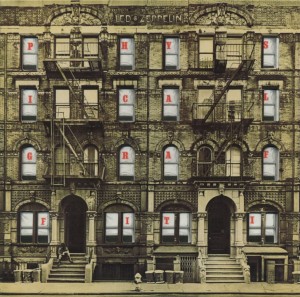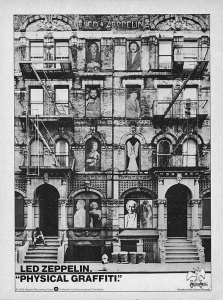Let’s face it: Led Zeppelin peaked with ‘Led Zeppelin IV’. Or whatever you choose to call it.
‘Houses of the Holy’ was a bit of a come-down, with Plant’s high-register vocals sounding comical in places, and two throwaway tracks, “The Crunge” and “D’yer Mak’er”, wasting about 7.5 minutes of the record. And no one’s ever going to convince me that ‘Presence’ is a great or even good album. The band sound thin, tired, and worn-out, and the songs (yes, with a few exceptions) are weak. ‘In Through the Out Door’? Please.
Many would argue that the mighty Zep peaked with ‘Physical Graffiti’, often referred to as Led Zeppelin’s tour de force, their magnum opus, their epic masterwork. I agree with all the hyperbole; the record, as delivered, is amazing, and perhaps their definitive work. But there’s another album hidden inside ‘Physical Graffiti’, an album that is seldom acknowledged when this record is discussed. Of the 15-tracks on this sprawling 2-record set, only 8 were recorded for at Headley Grange in early 1974 for Led Zep’s sixth studio album. It’s these 8 songs that make up the real ‘Physical Graffiti’.
Why pick it apart? For those interested in following Led Zeppelin’s career trajectory, or their creative arc, the version of ‘Physical Graffiti’ that we all know and love does not paint an accurate picture of where the band was in terms of songwriting or musicianship in 1974, as it contains 7 songs (almost half of the album) that were recorded years before the ’74 sessions; some as far back as 1970. While there’s no doubt that Zeppelin’s outtakes and throwaways are far superior to most bands’ best material, the inclusion of so many older songs here obscures what was really going on with the band musically and creatively at this period in their history. Dealing with the material from the ’74 sessions exclusively is the only way to truly understand and appreciate Led Zeppelin’s 6th studio album.
So what have we got here? The eight songs at the heart of ‘Physical Graffiti’ (in order of their appearance on the album) are:
Custard Pie
In My Time of Dying
Trampled Under Foot
Kashmir
In the Light
Ten Years Gone
The Wanton Song
Sick Again
This ‘album’ clocks in at a little over 53 minutes, which is why the band, rather than cut out 10 minutes of new material, opted instead to expand the project to a 2-record set by adding some leftovers from previous sessions. This moved the album away from being a major statement like ‘Exile on Main Street’ or the ‘White Album’ and into compilation album territory. But with the older songs eliminated, one can appreciate the record in an entirely new and different way. I have the songs set up this way in my iTunes, without all of the extraneous material, and have been listening to this version of the album for a few years, long enough to have fooled my brain into perceiving it in the same way it perceives ‘Houses…’ or ‘Presence’ or ‘III’. For me, this is Led Zeppelin’s 6th album… This is ‘Physical Graffiti’.
The verdict? No surprises here; it’s still great. But removing all of the extraneous material reveals what could easily be considered Led Zep’s heaviest album. It’s certainly their last great one. Any band would kill to sound this vital, this dangerous, on their sixth studio album. The production is a little ragged (Plant himself called the sessions ‘really raunchy’); however, the lack of the fourth album’s production polish suits the material. Many of the vocals were cut live and are a tad low in the mix, perhaps to hide the rough edges evident in some of the performances. Page’s multi-layered guitar arrangements, at the forefront on ‘Houses…’, are in evidence everywhere. John Paul Jones, Zep’s secret weapon, shines on keyboards in several songs, most notably on “In the Light” and “Trampled Under Foot”. Bonham sounds absolutely massive, as ever. The songs are at once hard-hitting and dynamic; crushing blues, wistful balladry, Middle Eastern prog, and razor-sharp hard rock— the only thing missing is an acoustic number. But what this version of the record lacks in scope when compared to the double-album version, it makes up for in raw creativity, not to mention raw power. It makes perfect sense as a successor to ‘Houses…’, has its own distinct personality, and is more than worthy of recognition on its own without all the extra baggage.
Zep Fans: Take a few minutes and set up the real ‘PG’ in your mp3 player and check it out with fresh ears; revisit the classic record and discover the buried treasure within. I still think they peaked with ‘IV’. But the true ‘Physical Graffiti’, not that overblown yard sale of a 2-record set, is my favorite Led Zeppelin album. After all, I ‘produced’ it myself.

